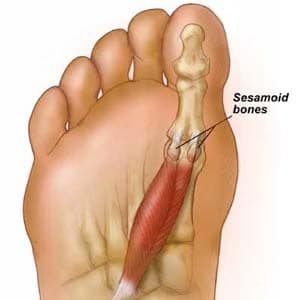
Sesamoiditis
Sesamoiditis is an inflammation of one or both of the sesamoid bones in the first metatarsal joint (the big toe). This bone causes pain and discomfort under and around the joint of the big toe. The big toe is a very important joint for locomotion as it is the last point of contact with the ground during toe-off

What is a sesamoid bone?
A sesamoid is an anatomical term given to a bone that sits within the tendon of a muscle. The most commonly known sesamoid bone is the patella, which sits inside the tendon of the quadriceps muscle.
A sesamoid bone functions by providing a mechanical advantage to a joint’s range of motion by increasing its lever arm. An increase to the lever arm of a joint reduces the energy required by the body to produce movement.
So biomechanically speaking, sesamoid bones create more efficient movement.
The foot has two common sesamoid bones, located at the base of the head of the first metatarsal (The ball of the foot at the big toe). These bones are located in the tendon of the muscle flexor hallucis brevis, which is a small muscle responsible for pushing the big toe into the ground, particularly during the toe-off phase of walking.
The word sesamoid derives from the Greek translating of “sesame-seed like” identifying the small, smooth structure of the bones.
Why are there sesamoid bones in my feet?
The sesamoid bones are very important to the function of the foot as they help absorb impact and increase the forces generated through movement. The bones act similarly to pulley, increasing the leverage of tendons and forces produced by gait.
Due to the position of the sesamoid bones in the foot and their role, the sesamoid bones are put through a lot of pressure during locomotion. Large increases in training load or movement put a lot more pressure through the sesamoid bones and this leaves them prone to injury.
What is Sesamoiditis, how does it happen?
A common ailment affecting the ball of the foot and big toe, sesamoiditis is the condition when the sesamoids become inflamed or irritated.
There are a number of factors which can contribute to the development of sesamoiditis which include:
- Poor Biomechanics/Malalignment can cause of overload of the sesamoid bones and surrounding soft tissue. Both collapsed and high arches can contribute to the development of symptoms.
- Acute overtraining or sudden increases in training load will increase forces travelling through the feet before the structures can adapt and manage them. This can cause inflammation and overuse injuries of the sesamoid bones.
- Trauma to the ball of the foot, such as landing from a height, can cause inflammation or fracture of the sesamoids.
- Poorly Fitting or Inappropriate Footwear can cause poor alignment or increase pressure through the sesamoids. This is common when consistently wearing hard-soled or high-heeled shoes.
Signs and Symptoms of Sesamoiditis?
The symptoms associated with sesamoiditis are quite clear and when reported to a physiotherapist will lead to a quick diagnosis.
The primary symptom of sesamoiditis is pain under the base of the big toe. Pain experienced from sesamoiditis progresses gradually as opposed to an immediate onset indicating fracture. A fracture can be cleared if symptoms indicate one.
Initially, pain will be experienced when the bending and straightening the big toe. As the condition progresses, the area under the big toe will become tender with any activity.
In longstanding cases patients may report pain all the time. The pain is usually worse when the patient is on their feet. There may also be swelling, bruising or inflammation of the area.
How to Treat Sesamoiditis?
Unsurprisingly, the first step in treating sesamoiditis is diagnosis. Whilst an assessment of symptoms is usually sufficient to diagnose the injury, medical imaging (x-ray, ultrasound, or CT scans) may be necessary to evaluate the severity and optimal treatment.
Once diagnosed, sesamoiditis is typically treated by addressing the cause of pain. Treatment is usually conservative, however, if unsuccessful, then surgical intervention may be required.
Treatment will prioritise deloading the sesamoid bones and immediately stopping activity which aggravates the injury. Application of ice and use of an oral anti-inflammatory will help to relieve pain and can be used in conjunction with immobilization strapping to initially treat the disease.
Application of a foam pad and soft, low heeled shoes are also recommended. Our physiotherapist will also develop a gradual return-to-activity program to ensure correct recovery and prevent recurrence of pain.



